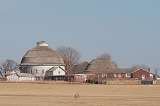
University of Illinois round barns
Encyclopedia
The three University of Illinois round barns played a special role in the promotion and popularity of the American round barn. They are located in the U.S. city of Urbana, Illinois
on the campus of the University of Illinois (U of I). The University of Illinois
was home to one of the Agricultural Experiment Stations, located at U.S. universities, which were at the heart of the promotion of the round barn. At least one round barn in Illinois was built specifically after its owner viewed the barns at the university. Though originally an experiment the three barns helped to lead the way for round barn
construction throughout the Midwest, particularly in Illinois. The barns were listed as contributing properties to the U of I Experimental Dairy Farm Historic District, which was listed on the U.S. National Register of Historic Places in 1994.
provided federal funds. After its initial establishment U of I's College of Agriculture began to grow and it was divided into three distinct components, classroom instruction at U of I, the Agricultural Experiment Station, and a state wide extension service. In 1899 Eugene Davenport replaced George E. Morrow as Dean of the College of Agriculture, he immediately reorganized the college into four departments, agronomy
, animal husbandry
, dairy husbandry, and horticulture
. The Experiment Station was originally established to "administer research activities within the College." The Department of Dairy Husbandry, seeking to increase milk productivity by promoting efficieny, prompted the Experiment Station to construct the Experimental Dairy Farm at an area known as South Farms. The layout and design incorporated three round barns.
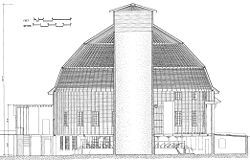 The three round barns in the historic district
The three round barns in the historic district
were inspired by the work of Benton Steele, Samuel Francis ("Frank") Detraz, Isaac and Emery McNamee, and Horace Duncan, who, in various combinations, had built at least 8 round barns in Indiana by mid-1902. Steele was an aggressive marketer of the circular barn concept, and in early 1902 began advertising in various agricultural newsletters. In 1903 his concepts caught the attention of Professor C. B. Dorsey of the University of Illinois Agricultural Experiment Station, who traveled to Indiana to view the barns built by Steele and his associates. Dorsey was apparently impressed, for he hired Steele and Detraz to construct a barn on his farm in Gilberts, Illinois. By 1908 Dorsey's interest in round barns had caught the eye of his University of Illinois colleage Wilber J. Fraser. Fraser was the first head of the Department of Dairy Husbandry from 1902 - 1913. He was also a strong advocate of the round barn which he said offered the "economy of consideration, low maintenance, and labor efficiency." Fraser asserted that round barns had a better ability to withstand Midwest windstorms as well. One barn was erected in 1907-08, 1910 or 1912 and the third c. 1912 or 1913, sources vary as to exact dates. The University of Illinois was then, and still is today, home to an Agricultural Experiment Station, these stations, located at universities throughout the United States were at the forefront of round barn promotion. The barns at the University of Illinois were instrumental in round barn era. In Illinois, at least one round barn was built with direct inspiration from the U of I round barns.
The first barn was built around 1907 or 1908 and was known as the Twenty Acre Dairy Barn; it was erected at a cost of US$
3,200. The 1910 Dairy Horse Barn set the university back an additional $2,000 and the 1912 Dairy Experiment Barn was the most expensive at $11,000.
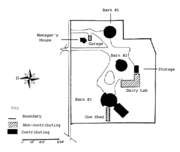 The barns were engineered by and designed by James M. White and Kell & Bernard. They were built every two years from 1908–1912 and as such, incorporated advances in construction and design to improve each subsequent round barn. Two of the three University of Illinois barns are built into hillsides, providing an example of banked barns. White, the university architect, acted as supervising architect. Little is known about Kell & Bernard.
The barns were engineered by and designed by James M. White and Kell & Bernard. They were built every two years from 1908–1912 and as such, incorporated advances in construction and design to improve each subsequent round barn. Two of the three University of Illinois barns are built into hillsides, providing an example of banked barns. White, the university architect, acted as supervising architect. Little is known about Kell & Bernard.
 The 1908 Twenty Acre Dairy Barn, the earliest of the three round barns at U of I, is an example of a banked barn. Its northwest face is entirely exposed while the rest of the barn and its foundation rests within a hillside. The 60 feet (18.3 m) diameter barn's interior is dominated by a large central silo which extends from the basement to the apex of the roof.
The 1908 Twenty Acre Dairy Barn, the earliest of the three round barns at U of I, is an example of a banked barn. Its northwest face is entirely exposed while the rest of the barn and its foundation rests within a hillside. The 60 feet (18.3 m) diameter barn's interior is dominated by a large central silo which extends from the basement to the apex of the roof.
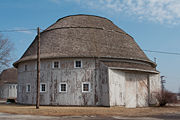 Through advances in construction technology the 1910 Dairy Horse Barn was constructed without the use of scaffolding
Through advances in construction technology the 1910 Dairy Horse Barn was constructed without the use of scaffolding
. The interior of this 60 feet (18.3 m) diameter building is divided into two stories; the lower level has a concrete floor.
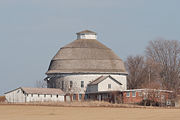 The most expensive of the three barns, the 1912 Dairy Experiment Barn (Barn #3 on the map), is also the largest, at 70 feet (21.3 m) in diameter. Located on a hillside, it is the furthest barn from the Manager's House. The hillside around the building's north side was entirely excavated, thus it has its basement entirely exposed on that elevation. The south and west portions of the barn rest within the hillside giving the building a banked quality. This final round barn at U of I was built with a "wing" which allowed more cattle to be stored in the building.
The most expensive of the three barns, the 1912 Dairy Experiment Barn (Barn #3 on the map), is also the largest, at 70 feet (21.3 m) in diameter. Located on a hillside, it is the furthest barn from the Manager's House. The hillside around the building's north side was entirely excavated, thus it has its basement entirely exposed on that elevation. The south and west portions of the barn rest within the hillside giving the building a banked quality. This final round barn at U of I was built with a "wing" which allowed more cattle to be stored in the building.
when it joined the National Register of Historic Places
on February 4, 1994. The barns played a broader role in the history of American agriculture, specifically in the Midwest states. The barns at the University of Illinois were part of a larger move by Agricultural Experiment Stations meant to promote round barn design, mostly on account of their "efficiency." For a time, the round barn became a popular design across the Midwest, with hundreds being constructed in Illinois
and Indiana
alone. While the earliest round barns date to the 1820s, earlier if the round barn at Mount Vernon
is included, the "round barn era" spanned the decades from 1880 to 1920.
In Illinois the round barns at the University of Illinois led to an increase in the style's popularity statewide. This was due, in part, to the access to audience that the U of I's Agricultural Experiment Station has through the publication of regular "Bulletins." The Agricultural Experiment Station Bulletin coupled with an article by H.C. Crouch touting round barns in the Illinois Agriculturalist led to the construction of round barns across the state. Anecdotal evidence
of the impact of the University of Illinois round barns can be collected from farmers today. Stories about fathers and grandfathers recollect round barns being constructed on account of what was going on "over at the University."
Urbana, Illinois
Urbana is the county seat of Champaign County, Illinois, United States. As of the 2010 census, the population was 41,250. Urbana is the tenth-most populous city in Illinois outside of the Chicago metropolitan area....
on the campus of the University of Illinois (U of I). The University of Illinois
University of Illinois at Urbana-Champaign
The University of Illinois at Urbana–Champaign is a large public research-intensive university in the state of Illinois, United States. It is the flagship campus of the University of Illinois system...
was home to one of the Agricultural Experiment Stations, located at U.S. universities, which were at the heart of the promotion of the round barn. At least one round barn in Illinois was built specifically after its owner viewed the barns at the university. Though originally an experiment the three barns helped to lead the way for round barn
Round barn
A round barn is a historic barn design that could be octagonal, polygonal, or circular in plan. Though round barns were not as popular as some other barn designs, their unique shape makes them noticeable. The years from 1880–1920 represent the height of round barn construction. Round barn...
construction throughout the Midwest, particularly in Illinois. The barns were listed as contributing properties to the U of I Experimental Dairy Farm Historic District, which was listed on the U.S. National Register of Historic Places in 1994.
History
The Agricultural Experiment Station at the University of Illinois was formed in 1888, one year after the Hatch ActHatch Act of 1887
The Hatch Act of 1887 gave federal funds, initially of $15,000 each, to state land-grant colleges in order to create a series of agricultural experiment stations, as well as pass along new information, especially in the areas of soil minerals and plant growth...
provided federal funds. After its initial establishment U of I's College of Agriculture began to grow and it was divided into three distinct components, classroom instruction at U of I, the Agricultural Experiment Station, and a state wide extension service. In 1899 Eugene Davenport replaced George E. Morrow as Dean of the College of Agriculture, he immediately reorganized the college into four departments, agronomy
Agronomy
Agronomy is the science and technology of producing and using plants for food, fuel, feed, fiber, and reclamation. Agronomy encompasses work in the areas of plant genetics, plant physiology, meteorology, and soil science. Agronomy is the application of a combination of sciences like biology,...
, animal husbandry
Animal husbandry
Animal husbandry is the agricultural practice of breeding and raising livestock.- History :Animal husbandry has been practiced for thousands of years, since the first domestication of animals....
, dairy husbandry, and horticulture
Horticulture
Horticulture is the industry and science of plant cultivation including the process of preparing soil for the planting of seeds, tubers, or cuttings. Horticulturists work and conduct research in the disciplines of plant propagation and cultivation, crop production, plant breeding and genetic...
. The Experiment Station was originally established to "administer research activities within the College." The Department of Dairy Husbandry, seeking to increase milk productivity by promoting efficieny, prompted the Experiment Station to construct the Experimental Dairy Farm at an area known as South Farms. The layout and design incorporated three round barns.

Historic district
A historic district or heritage district is a section of a city which contains older buildings considered valuable for historical or architectural reasons. In some countries, historic districts receive legal protection from development....
were inspired by the work of Benton Steele, Samuel Francis ("Frank") Detraz, Isaac and Emery McNamee, and Horace Duncan, who, in various combinations, had built at least 8 round barns in Indiana by mid-1902. Steele was an aggressive marketer of the circular barn concept, and in early 1902 began advertising in various agricultural newsletters. In 1903 his concepts caught the attention of Professor C. B. Dorsey of the University of Illinois Agricultural Experiment Station, who traveled to Indiana to view the barns built by Steele and his associates. Dorsey was apparently impressed, for he hired Steele and Detraz to construct a barn on his farm in Gilberts, Illinois. By 1908 Dorsey's interest in round barns had caught the eye of his University of Illinois colleage Wilber J. Fraser. Fraser was the first head of the Department of Dairy Husbandry from 1902 - 1913. He was also a strong advocate of the round barn which he said offered the "economy of consideration, low maintenance, and labor efficiency." Fraser asserted that round barns had a better ability to withstand Midwest windstorms as well. One barn was erected in 1907-08, 1910 or 1912 and the third c. 1912 or 1913, sources vary as to exact dates. The University of Illinois was then, and still is today, home to an Agricultural Experiment Station, these stations, located at universities throughout the United States were at the forefront of round barn promotion. The barns at the University of Illinois were instrumental in round barn era. In Illinois, at least one round barn was built with direct inspiration from the U of I round barns.
The first barn was built around 1907 or 1908 and was known as the Twenty Acre Dairy Barn; it was erected at a cost of US$
United States dollar
The United States dollar , also referred to as the American dollar, is the official currency of the United States of America. It is divided into 100 smaller units called cents or pennies....
3,200. The 1910 Dairy Horse Barn set the university back an additional $2,000 and the 1912 Dairy Experiment Barn was the most expensive at $11,000.
Design

Twenty Acre Dairy Barn

Dairy Horse Barn

Scaffolding
Scaffolding is a temporary structure used to support people and material in the construction or repair of buildings and other large structures. It is usually a modular system of metal pipes or tubes, although it can be from other materials...
. The interior of this 60 feet (18.3 m) diameter building is divided into two stories; the lower level has a concrete floor.
Dairy Experiment Barn

Significance
The Twenty Acre Dairy Barn, the Dairy Horse Barn, and the Dairy Experiment Barn were all listed as contributing properties within the University of Illinois Experimental Dairy Farm Historic DistrictUniversity of Illinois Experimental Dairy Farm Historic District
The University of Illinois Experimental Dairy Farm Historic District, also known as South Farm, is a designated historic district in the U.S. state of Illinois. It is located on the campus of the University of Illinois in Urbana, Illinois. The district consists of eight contributing structures and...
when it joined the National Register of Historic Places
National Register of Historic Places
The National Register of Historic Places is the United States government's official list of districts, sites, buildings, structures, and objects deemed worthy of preservation...
on February 4, 1994. The barns played a broader role in the history of American agriculture, specifically in the Midwest states. The barns at the University of Illinois were part of a larger move by Agricultural Experiment Stations meant to promote round barn design, mostly on account of their "efficiency." For a time, the round barn became a popular design across the Midwest, with hundreds being constructed in Illinois
Illinois
Illinois is the fifth-most populous state of the United States of America, and is often noted for being a microcosm of the entire country. With Chicago in the northeast, small industrial cities and great agricultural productivity in central and northern Illinois, and natural resources like coal,...
and Indiana
Indiana
Indiana is a US state, admitted to the United States as the 19th on December 11, 1816. It is located in the Midwestern United States and Great Lakes Region. With 6,483,802 residents, the state is ranked 15th in population and 16th in population density. Indiana is ranked 38th in land area and is...
alone. While the earliest round barns date to the 1820s, earlier if the round barn at Mount Vernon
Mount Vernon
The name Mount Vernon is a dedication to the English Vice-Admiral Edward Vernon. It was first applied to Mount Vernon, the Virginia estate of George Washington, the first President of the United States...
is included, the "round barn era" spanned the decades from 1880 to 1920.
In Illinois the round barns at the University of Illinois led to an increase in the style's popularity statewide. This was due, in part, to the access to audience that the U of I's Agricultural Experiment Station has through the publication of regular "Bulletins." The Agricultural Experiment Station Bulletin coupled with an article by H.C. Crouch touting round barns in the Illinois Agriculturalist led to the construction of round barns across the state. Anecdotal evidence
Anecdotal evidence
The expression anecdotal evidence refers to evidence from anecdotes. Because of the small sample, there is a larger chance that it may be true but unreliable due to cherry-picked or otherwise unrepresentative of typical cases....
of the impact of the University of Illinois round barns can be collected from farmers today. Stories about fathers and grandfathers recollect round barns being constructed on account of what was going on "over at the University."
External links
- Survey number HABS IL-1211 - University of Illinois Round Barns, Urbana, Champaign County, IL.

